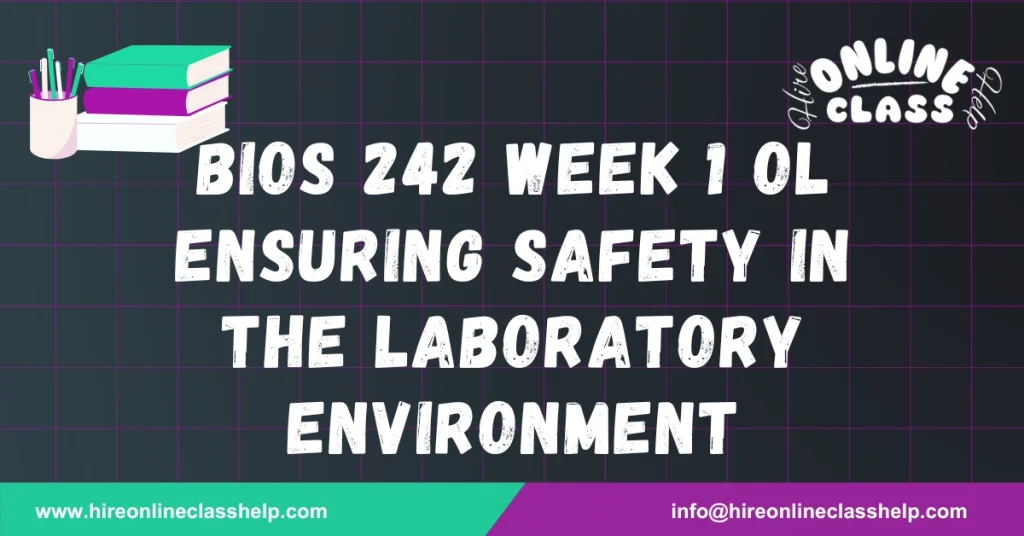






Name
Chamberlain University
BIOS-242 Fundamentals of Microbiology
Prof. Name
Date
Understand and Implement Appropriate Clothing for Laboratory Work:
One of the key components of laboratory safety is wearing the proper attire, which includes protective clothing. Closed-toe shoes, lab coats, and safety goggles are essential to protect oneself from spills, splashes, and other potential hazards. By implementing these safety measures, you can minimize the risk of injury in the lab.
Identify and Adhere to Laboratory Do’s and Don’ts:
Knowing the basic rules of laboratory conduct is crucial for maintaining a safe environment. This involves understanding what activities are permitted and which behaviors must be avoided to prevent accidents and ensure that the lab operates smoothly.
Demonstrate Proper Use of Lab Safety Equipment:
Properly using lab safety equipment, such as fire extinguishers, eye wash stations, and spill kits, is an integral part of laboratory work. Being able to operate this equipment effectively will prepare you to handle emergencies and ensure the safety of both yourself and others in the lab.
React Effectively in Emergencies:
Emergencies can arise unexpectedly in laboratory environments. The ability to respond calmly and correctly can significantly reduce the severity of the situation. Learning how to react in emergencies ensures that you can protect yourself and your peers from potential harm.
Laboratory environments come with inherent risks, especially for individuals unfamiliar with their protocols and procedures. In this virtual simulation, participants are given a hands-on experience in a simulated laboratory environment, allowing them to learn crucial skills such as utilizing lab safety equipment and responding appropriately to emergencies. By identifying and addressing potential hazards, you will cultivate a safe working environment and gain valuable knowledge to share with others.
The identification and removal of potential hazards are critical to maintaining a clean and secure workspace. By familiarizing yourself with laboratory safety regulations and equipment, you can develop the necessary skills to respond effectively during an incident. These insights are invaluable in real-life laboratory situations, where adherence to safety rules and the use of proper equipment can prevent accidents and mitigate risks.
Understanding hazard symbols and their meanings is a vital aspect of lab safety. This knowledge empowers you to take the necessary precautions to avoid hazardous situations, such as chemical spills. The simulation will teach you how to handle unlabeled chemicals, manage various scenarios, and safely operate lab safety equipment like eye wash stations and other essential devices.
Sharing your expertise is essential for promoting a safety-conscious culture within the lab environment. You will be able to teach new lab workers the importance of safety protocols, including proper attire and safe practices. By imparting this knowledge, you contribute to a safer workspace and empower others to prioritize safety.
This virtual simulation will give you the confidence to navigate real-life lab settings with diligence and precaution, ensuring both your safety and the safety of those around you. Remember, a commitment to lab safety is key to safeguarding everyone in the lab environment.
The purpose of conducting lab safety experiments is to familiarize yourself with the proper procedures and equipment necessary for maintaining a safe environment. By participating in these experiments, you will develop proficiency in identifying hazardous chemical symbols and understanding the locations and functions of safety devices. This mindset of safety and precaution is crucial for laboratory work.
Wearing closed-toe shoes in the lab is an essential safety measure that protects your feet from potential spills of harmful chemicals. This precaution minimizes the risk of injury, such as chemical burns, and ensures that your feet are safeguarded from accidental exposure to hazardous materials.
Maintaining a clean workbench is critical in laboratory settings. Before beginning any work, cleaning the workbench ensures that no residual pathogens or contaminants compromise the experiment’s integrity. Cleaning after use prevents contamination for the next user, ensuring that the laboratory remains a safe and sterile environment.
Conduct a Spill Test:
Begin by identifying the spilled chemical to determine the appropriate cleanup procedure.
Use a Neutralizing Agent:
Once the chemical is identified, apply the proper neutralizing agent to counteract its effects.
Remove the Spill:
Absorbent paper or materials should be used to remove the spill carefully from the surface.
Sanitize the Workbench:
After removing the spill, sanitize the workbench using disinfectants or sterilizing agents to ensure the environment is sterile.
Broken Glass or Sharp Objects:
Place these materials in designated glass hazard bins to minimize injury risk during disposal.
Materials Contaminated with Blood or Body Fluids:
Dispose of these items in biohazard bins to contain infectious agents.
Used Gloves:
If gloves are uncontaminated, they can be disposed of in regular trash bins. If contaminated, they should be placed in biohazard bins.
This lab exercise provided me with valuable insights into laboratory safety practices. I learned the importance of dressing appropriately, such as wearing closed-toe shoes, and securing long hair to minimize risks. The simulation also emphasized the significance of identifying hazardous chemical symbols and understanding the operation of emergency stations. These practices have enhanced my preparedness for conducting experiments safely and competently within a laboratory setting.
American Psychological Association. (2020). Publication manual of the American Psychological Association (7th ed.).